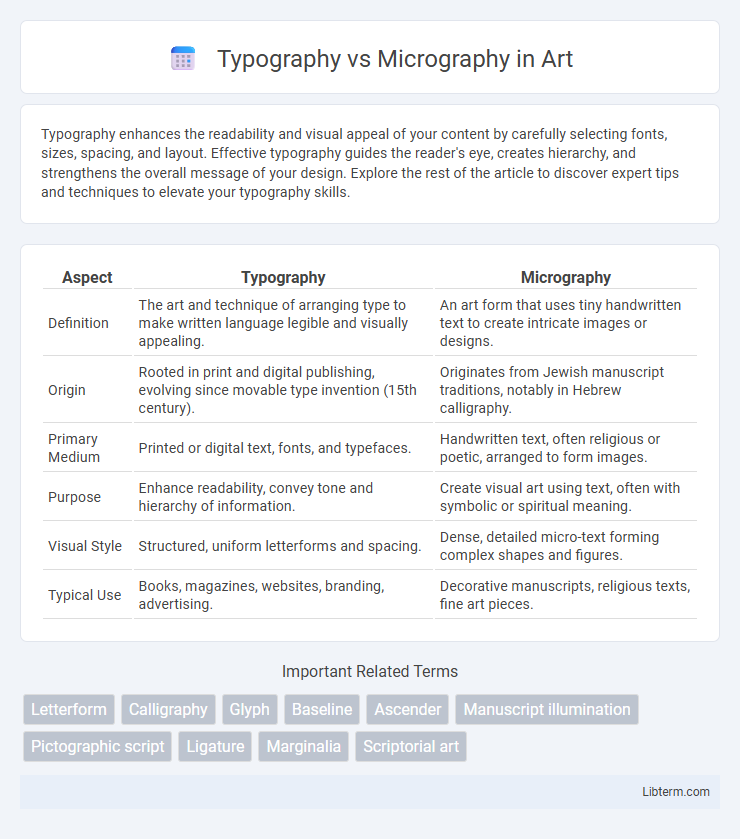Typography enhances the readability and visual appeal of your content by carefully selecting fonts, sizes, spacing, and layout. Effective typography guides the reader's eye, creates hierarchy, and strengthens the overall message of your design. Explore the rest of the article to discover expert tips and techniques to elevate your typography skills.
Table of Comparison
| Aspect | Typography | Micrography |
|---|---|---|
| Definition | The art and technique of arranging type to make written language legible and visually appealing. | An art form that uses tiny handwritten text to create intricate images or designs. |
| Origin | Rooted in print and digital publishing, evolving since movable type invention (15th century). | Originates from Jewish manuscript traditions, notably in Hebrew calligraphy. |
| Primary Medium | Printed or digital text, fonts, and typefaces. | Handwritten text, often religious or poetic, arranged to form images. |
| Purpose | Enhance readability, convey tone and hierarchy of information. | Create visual art using text, often with symbolic or spiritual meaning. |
| Visual Style | Structured, uniform letterforms and spacing. | Dense, detailed micro-text forming complex shapes and figures. |
| Typical Use | Books, magazines, websites, branding, advertising. | Decorative manuscripts, religious texts, fine art pieces. |
Introduction to Typography and Micrography
Typography involves the art and technique of arranging type to make written language legible, readable, and visually appealing, focusing on font selection, size, spacing, and layout principles. Micrography, a Jewish art form, uses minute Hebrew letters to create intricate designs or images, combining textual content with artistic expression. Both disciplines emphasize visual communication but differ in methodology, with typography prioritizing textual clarity and micrography blending text with visual patterns.
Defining Typography: Art and Science of Type
Typography is the art and science of designing and arranging type to make written language legible, readable, and visually appealing across various media. It involves selecting typefaces, point sizes, line lengths, line-spacing, and letter-spacing to enhance communication and aesthetic impact. Unlike micrography, which uses tiny text to create intricate images, typography focuses on the functional and artistic presentation of text itself.
What is Micrography? Origins and Evolution
Micrography is a Jewish art form that uses minute Hebrew script to create intricate visual designs, serving both decorative and textual purposes. Originating in the 9th century in the Middle East, this technique evolved from scribal traditions that combined religious texts with artistic expression, particularly flourished in medieval manuscripts. Over centuries, micrography expanded beyond religious contexts to include secular themes, influencing contemporary calligraphy and graphic design practices.
Visual Differences: Typography vs Micrography
Typography utilizes varied fonts, sizes, and spacing to create visually distinct and easily readable text, emphasizing clarity and design aesthetics. Micrography, an ancient Jewish art form, arranges tiny Hebrew letters to form intricate images or decorative motifs, merging text with visual storytelling. The primary visual difference lies in typography's focus on legibility and text hierarchy, while micrography prioritizes artistic representation through dense, miniature script patterns.
Historical Context and Cultural Significance
Typography, emerging in the 15th century with Gutenberg's movable type, revolutionized mass communication by standardizing and democratizing text production across Europe, profoundly influencing Western culture and literacy. Micrography, a Jewish art form dating back to the 9th century, uses minute Hebrew script to create intricate visual compositions, serving both religious devotion and cultural preservation within the Jewish Diaspora. While typography emphasizes mechanical reproduction and dissemination, micrography embodies a fusion of textual content and artistic expression, reflecting distinct historical trajectories and cultural identities.
Artistic Techniques in Typography and Micrography
Artistic techniques in typography emphasize the deliberate manipulation of typefaces, spacing, and layout to create visually compelling text that enhances readability and aesthetic appeal. Micrography, an ancient Jewish art form, utilizes tiny written letters to form intricate images or patterns, blending calligraphy with visual storytelling. Both disciplines merge artistic expression with textual communication, but typography primarily focuses on design and legibility, while micrography transforms text into complex images through meticulous hand lettering.
Practical Applications in Modern Design
Typography leverages digital fonts and scalable vector graphics to create visually appealing, readable text across websites, mobile apps, and branding materials, enhancing user experience and brand identity. Micrography utilizes intricate arrangements of tiny handwritten or printed text within design elements, often seen in fine art pieces, packaging, and bespoke invitations to convey deeper meaning or texture. Both practices play crucial roles in modern design by balancing legibility with aesthetic detail, where typography excels in mass communication and micrography adds artisanal uniqueness.
Advantages and Challenges of Each Approach
Typography offers precise control over letterforms, enabling consistent readability and scalable design across digital and print media, but it can lack the personal, artistic touch that customized fonts provide. Micrography incorporates tiny handwritten text to form images, adding unique aesthetic appeal and cultural depth, yet it demands meticulous craftsmanship and may suffer from legibility issues at smaller sizes. Choosing between typography and micrography depends on balancing scalability and clarity against expressive, intricate detail.
Integrating Typography and Micrography in Projects
Integrating typography and micrography in design projects enhances visual storytelling by combining the precision of typefaces with the intricate detail of hand-drawn text art, creating unique, engaging compositions. Utilizing micrography's fine textures within typographic layouts enriches readability and adds artistic depth, making printed or digital media more memorable. Effective integration requires balancing legibility and ornamentation, often achieved through layering techniques and attention to scale, ensuring the text remains both decorative and communicative.
Future Trends in Typographic and Micrographic Art
Emerging AI-driven design tools are revolutionizing the future of typography and micrography by enabling hyper-personalized and adaptive typefaces that respond to user interaction and context. Advances in nano-printing and augmented reality technology promise to blur the lines between traditional micrographic art and digital typographic displays, facilitating intricate, scalable text art in new media environments. Integration of variable fonts with micrographic patterns is anticipated to enhance both readability and artistic expression in branding, advertising, and immersive digital experiences.
Typography Infographic

 libterm.com
libterm.com